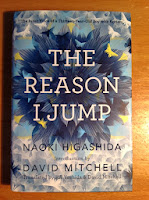 The full title of this book is The Reason I Jump: The Inner Voice of a Thirteen Year-Old Boy with Autism by Naoki Higashida, a Japanese boy who is an advocate, motivational speaker, and author of several other fiction and nonfiction books. I picked this book up because, like many people, autism is a fairly big mystery to me, and probably always will be to some extent. And Higashida's book attempts to provide some answers directly from someone who lives with autism everyday.
The full title of this book is The Reason I Jump: The Inner Voice of a Thirteen Year-Old Boy with Autism by Naoki Higashida, a Japanese boy who is an advocate, motivational speaker, and author of several other fiction and nonfiction books. I picked this book up because, like many people, autism is a fairly big mystery to me, and probably always will be to some extent. And Higashida's book attempts to provide some answers directly from someone who lives with autism everyday.
Genre, Themes, History: This is a nonfiction book that almost resembles a conversation more than it does a book. Higashida answers 58 common questions that are asked about those with autism, including "why do you like spinning," "what causes panic attacks and meltdowns," "why do you make a huge fuss over tiny mistakes," and even "why can you never stay still?" Higashida's answers are both enlightening and fascinating. He was diagnosed with autism at the age of five, and for him, spoken communication is next to impossible. This book, and also his other books, were written with the help of a Japanese alphabet grid where Higashida points to letters to spell out words, which a helper then transcribes. The Reason I Jump was actually first published in Japan in 2007, but has now been translated and published in English due to the efforts of David Mitchell (author of Cloud Atlas) and his wife Ka Yoshida, who have an autistic child of their own. Mitchell and Yoshida first translated the book for friends and family, but quickly discovered how useful the information would be to the greater population. And in between Higashida's answers are short fictional stories that he has also written. The book certainly dispels one of the most commonly held beliefs that people with autism are antisocial loners who lack empathy for others and their feelings. Higashida mentions over and over how bad he feels knowing that his actions sometimes disturb other people, making them uncomfortable and making them lose patience. His main plea is for others to not give up on him and others with autism and to keep trying.
My Verdict: This book is useful for anyone who has ever had any contact, however limited, with any autistic person anywhere ever. In other words, everyone should probably read it. Even those who are autism specialists. It is fairly short, clocking in at only 139 pages. I read it in a day, but what I learned is pretty invaluable. And it's honest answers straight from the source. What could be more useful than that?
Favorite Moment: When asked the reason why he jumps, Higashida ends his answer with this statement, "Ah, if only I could just flap my wings and soar away, into the big blue yonder, over the hills and far away!"
Recommended Reading: I haven't read any other books on autism, or special needs children or adults. Susannah Cahalan's Brain on Fire: My Month of Madness tells the story from the author's point of view of her struggle to overcome a mysterious disease that quickly took over her body and almost ended her life had a doctor not been able to finally diagnose her successfully. Even though there is an entire month of the ordeal that Cahalan doesn't remember, the whole account is written in the first person and based off of the doctor's notes, and also the stories and testimonies of close friends and family.
No comments:
Post a Comment